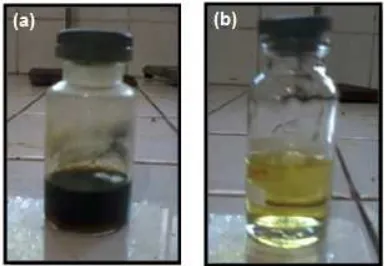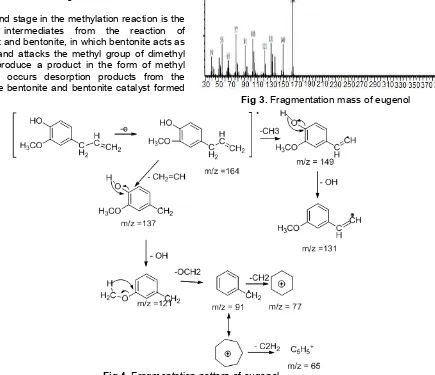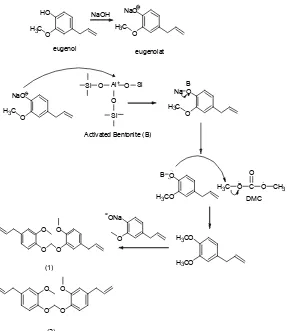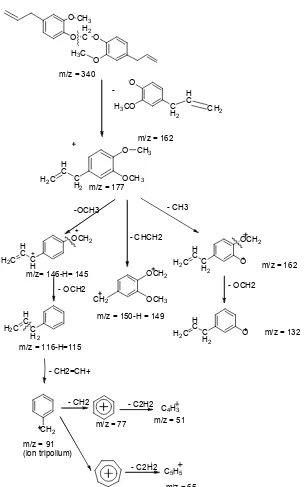METHYLATION OF EUGENOL USING DIMETHYL CARBONATE AND BENTONITE
AS CATALYST
Dina Asnawati
1,2,*, I Made Sudarma
2, Emmy Yuanita
2, Baiq Fadila Arlina
2,
Saprini Hamdiani
2, and Siti Raudhatul Kamali
21
Department of Chemistry, Faculty of Science, Mataram University Jl. Majapahit 62 Mataram 83125, Indonesia
2
Natural Products, Synthesis and Transformation Research Groups, Mataram University Jl. Majapahit 62 Mataram 83125, Indonesia
Received October 8, 2014; Accepted May 6, 2015
ABSTRACT
Eugenol is a compound with a variety of reactive functional groups such as allyl, hydroxy and methoxy. The presence of the functional groups brings eugenol possible to undertake the transformation into various derivative compounds with diverse activities. One of the simple and possible transformations is methylation or alkylation. Commonly, methyl halides and dimethyl sulphate are used as methylation agent. However, those kinds of methylation agents are toxic and carcinogenic. In this research dimethyl carbonate, an alternative methylation agent is used, because of its low toxicity, green, and economic. The synthesis has been carried out by using a catalyst. Bentonite was activated by heating to a temperature using 300 °C. Methylation was shown by the formation of a light yellow liquid (25.71% yield). The structures of products were characterized by GC-MS and obtained a compound, namely bis eugenol (4-allyl-2-methoxyphenoxy) methane (2.37% yield).
Keywords:methyl eugenol; bentonite; dimethyl carbonate
ABSTRAK
Eugenol merupakan senyawa dengan berbagai gugus fungsi yang reaktif seperti alil, hidroksi dan metoksi. Keberadaan gugus fungsi tersebut memungkinkan untuk dilakukannya reaksi transformasi menjadi berbagai turunan senyawa dengan aktivitas beragam. Salah satu bentuk transformasi yang mungkin dan sederhana yaitu reaksi metilasi atau alkilasi. Selama ini reaksi metilasi menggunakan agen pengalkilasi metil halida dan dimetil sulfat tetapi agen metilasi ini memiliki nilai toksisitas tinggi dan bersifat karsinogenik. Untuk itu penelitian bertujuan untuk melakukan reaksi metilasi menggunakan agen alternatif pengganti berupa dimetil karbonat yang memiliki nilai toksisitas rendah, ramah lingkungan serta harganya relatif lebih murah. Sintesis dilakukan menggunakan katalis bentonit yang diaktivasi dengan menggunakan pemanasan hingga suhu 300 °C. Hasil reaksi berupa larutan berwarna kuning bening dengan rendemen sebesar 25,71%. Berdasarkan analisis GC-MS, diperoleh suatu senyawa yang diduga merupakan hasil dari reaksi metilasi eugenol yaitu bis(4-alil-2-metoksifenoksi) metana sebesar 2,37%.
Kata Kunci:metil eugenol; bentonit; dimetil karbonat
INTRODUCTION
Eugenol is a compound with a variety of reactive functional groups such as allyl, hydroxy and methoxy. The presence of these functional groups brings eugenol possible to undertake the transformation into various derivative compounds with diverse activities, through reactions such as substitution, addition, hydration, isomerization, oxidation, even methylation. One of the eugenol derivatives that have been developed is methyl eugenol. This compound is a sex pheromone component in the male fruit fly (Bactrocera dorsalis) [1-3]. In
addition, methyl eugenol can also be used as a base
for the manufacture of a cardiac stimulant drug
(α-methylnoradrenaline) [4], anti-hypertensive drugs and
Parkinson (L-α methyl dopa) [5], as a starting scaffold
to design eleven new and three known anti-tubulin agents [6], and also as botanical insecticides [7].
mechanism of eugenol was based on Williamson ether synthesis, where it is to convert the alcohol into the alkoxide with the addition NaOH. Then it was reacted with alkyl halide by heating (reflux). Commonly, methyl halides (CH3-X, LD50 0.076 g/kg) and dimethyl sulphate (DMS, LD500.44 g/kg) [8] was used as alkylating agents. However, those kind of alkylating agents are toxic and carcinogenic. Therefore, the use of both these reagents should be avoided. One alternative is to use dimethyl carbonate (DMC, LD50 of 13.8 g/kg) with low toxicity, environmentally friendly and relatively cheaper compared to other methylation agent. Methylation reaction of eugenol tends to be slow; therefore the addition of a catalyst is needed to accelerate the reaction rate so that the reaction time becomes shorter. One of the catalysts that can be used in the methylation reaction is bentonite. The main content of bentonite is montmorillonite clay with a large surface area and has a structure that allows the formation of Lewis acid sites. Therefore it has been used as a cation exchange, such as Al3+, Fe3+, Zn2+and so on, that are active as catalysts and has a surface as a Lewis acid. With these properties, bentonite is often used as a catalyst in various chemical reactions [9].
The ability of bentonite as a catalyst is related to its availability of active centers in the pores of between the bentonite. Active centers is due to the acidic function of Brønsted and Lewis type. Comparison of the two types of acid depends on the activation process and the reaction conditions. Active centers leads to acidic molecules that can bind chemically base. This characteristic is used in a variety of organic reactions such as isomerization, cracking of crude oil, and fuel synthesis [10]. One example of the application of bentonite as catalyst is the use of natural bentonite activated acid as a catalyst in the transesterification reaction of rubber seed oil. In this study, bentonite has been activated by the interaction of bentonite with acids liberates ions of Al3+, Fe3+, and Mg2+and other impurities from the crystal lattice structure so that the bentonite would be cleaner. Here we report the result of methylation reaction between eugenol using dimethyl carbonate and bentonite as catalyst.
EXPERIMENTAL SECTION
Materials
All materials were p.a. grade. Bentonite was purchased from Sigma Aldrich, eugenol was isolated from clove leaves, and NaOH, aquadest, diethyl ether, Na2SO4, TLC, dichloromethane (DCM), n-hexane were purchased from Merck.
Instrumentation
GC-MS were recorded on GC-MS QP-5050A, BC-17A and MS 5050A Shimadzu. GC Parameters were setup as follows, Oven Temp (°C) = 60.0; Oven Equil. Time (min) = 0.50; Injection Temp (°C) = 280.0; Interface Temp (°C) = 300.0; Column Length (m) = 30; Column Diameter (mm) = 0.25; Column Pressure (kPa) = 100; Column Flow (ml/min) = 1.6; Linear velocity = 46.4; Split Ratio = 22; Total Flow (ml/min) = 40.2; Program Time (min) = 27.00. MS parameter, Start M/Z = 33.00 End M/Z = 550.00; Scan interval (Sec.) = 0.50; Scan Speed (amu/sec) = 1000.
Procedure
Activation of bentonite
Activation reaction was based on method of [12], by heating the bentonite on the temperature 300 °C for one hour.
Methylation reaction
The reaction was adopting the method of methylation [2] with modifications. A three-neck flask of 500 mL has been equipped with air balls, magnetic stirrer, thermometer, and the dropper funnel 1.22 g (0.0074 mol) of eugenol. Into that flask, a solution of 0.36 g (0.0090 mol) of NaOH in 2 mL of distilled water was added and then stirred with a magnetic stirrer for 1 h. Further into the eugenolate salt, bentonite at 20% of the mass of eugenol was added. Through the dropper funnel, 0.76 mL of dimethyl carbonate was included dropwise while stirred for 1 h at room temperature. The mixture was then refluxed for 2 h to enhance the reaction at a temperature of 120–160 °C. The result was cooled and dissolved in 25 mL of distilled water to form two layers. The bottom layer was then extracted with 3x15 mL of diethyl ether. The top layer of all the extraction results were then washed with distilled water until neutral and then dried with anhydrous Na2SO4and filtered. The non-polar extract is evaporated, in order to obtain a clear yellow solution. The evaporated nonpolar extract was then tested by TLC using DCM eluent : n-hexane (1:1). Identification of the components is done by GC-MS spectrophotometer.
RESULT AND DISCUSSION
bentonite catalyst, where the eugenolat salt can act as a nucleophile [13]. The addition of dimethyl carbonate (DMC) to the mixture dropwise, was performed for an hour because the reaction that occurs is exothermic. To enhance the reaction, the mixture was then refluxed for 2 h accompanied by stirring at reflux conditions (T > 120 °C). In this research, reflux temperature above 120 °C was used, because this temperature is suitable for DMC to act as a methylation agent.
Basically, dimethyl carbonate (DMC) can act as a methylation agent. At reflux temperature of 90 °C (boiling point of DMC), DMC runs a methoxy carboxylation reaction, where the nucleophile will attack the carbonyl carbon of DMC so that the reaction products were in the form of esters. While at reflux temperature > 120 °C, DMC acts as a methylation agent in which the nucleophile will attack the methyl group of DMC [8]. Reflux method was used in the methylation process of eugenol, because the main principle of this method is by using a volatile solvent that will evaporate at high temperatures and condense in cooled temperature. A solvent that was in the form of vapor will condense on the condenser and go back down again into the reaction container, so that the solvent will always remain there during the reaction [13]. At this stage, the methylation agent of dimethyl carbonate (DMC) was added to the eugenolate salt together with bentonite as the catalyst. In this reaction bentonite acts as a catalyst that serves to lower the activation energy of the methylation reaction. Bentonite catalyst works by activating reagent as an activated complex, so it is easier to react with other reactants.
After the reflux, the mixture was cooled and then added distilled water to dissolve the sodium salt eugenolate and sodium hydroxide (NaOH) remaining. In addition, the mixture was added also with diethyl ether to take the rest of the organic phase washed in the water phase. At this stage, the solution forms a three-phase: organic phase on the top layer, the aqueous phase on the middle layer, and solids bentonite on the bottom layer. In this case the result of methylation of eugenol compounds will be distributed into the organic phase. This is because the natures of the compounds formed have the same polarity of the organic solvent used (diethyl ether) which is non-polar. In the extraction process, the organic phase is at the top because of
diethyl ether phase (ρ = 0.713 g/mL) had a smaller density compared with the density of water (ρ = 1 g/mL).
The organic phase was taken and added Na2SO4 anhydrous to remove remaining water content.
The methylation reaction of eugenol obtained a yield of 25.71% (stoichiometric conversion) and formed a clear yellow liquid as shown in Fig. 1.
The GC-MS chromatogram of the product obtained from the methylation reaction of eugenol is shown in Fig. 2.
The results of Gas Chromatography (GC) of the methylation reaction of eugenol can be seen in Table 1. Fig. 2 and Table 1 shows that the methylation reaction of eugenol has obtained two components: eugenol and bis(4-allyl-2-methoxyphenoxy)methane. Further analysis of the components is done by Mass Spectroscopy (MS).
Based on the Fig. 3, it can be seen that the highest peak is in 164 m/z. The peak of 164 m/z indicates the presence of a compound with a molecular weight of 164 g/mol and a molecular formula of C10H12O2. The fragmentation results can fit the typical fragmentation of eugenol compounds at m/z = 164, 149, 131, 121, 103, 91, 77, and 65 [14]. By comparing
Fig 1.The color of eugenol (a) before and (b) after the methylation reaction
Fig 2. GC-MS chromatogram of the product obtained from eugenol methylation reaction
Table 1.Results of Gas Chromatography (GC) of the eugenol methylation reaction
Peak R. Time Area % Compound
1 22.267 97.63 Eugenol
the retention time of peak 1 and the retention time of isolated eugenol (default) it is easy to ensure that the compound represented by peak 1 is eugenol. The retention times of peak 1 are respectively 22.267 and 22.233. This concludes that eugenol is peak number 1.
Fragmentation pattern of the compound eugenol can be seen in Fig. 4.
The results of GC-MS analysis revealed that peak 2 with an area of 2.67% is thought to be the compound bis (4-allyl-2-methoxyphenoxy) methane. This compound is formed from the reaction between methyl eugenol with eugenolate excess salt. This reaction can occur due to the acidic reaction conditions that lead to excess sodium eugenolate react with methyl eugenol.
The formation mechanism of the bis(4-allyl-2-methoxyphenoxy)methane compound begins with activating eugenolate salt with bentonite catalyst. In this reaction, bentonite is a Lewis acid which causes the bentonite easy to be attacked by nucleophiles. In this case eugenolate salt acts as a nucleophile that attacks the Lewis acid sites of bentonite. The reaction between the salt with bentonite eugenolate will then form intermediates.
The second stage in the methylation reaction is the formation of intermediates from the reaction of eugenolate salt and bentonite, in which bentonite acts as a nucleophile and attacks the methyl group of dimethyl carbonate to produce a product in the form of methyl eugenol. Here occurs desorption products from the catalyst surface bentonite and bentonite catalyst formed back.
Methyl eugenol, which is the target compound from the reaction of eugenol methylation, can also undergo reactions with eugenolate salt that still remains to form bis (4-allyl-2-methoxyphenoxy) methane. In this reaction, the oxygen atom in the eugenolate salt acts as nucleophile (rich of electrons) and then attacks the carbon atoms contained in the methoxy group of methyl eugenol. This reaction is a substitution reaction. The mechanism of eugenol methylation reaction is presented in Fig. 5.
From the mechanism (Fig. 5), it can be seen that the reaction between methyl eugenol and eugenolate salt can possibly produce (1) bis (4-allyl-2-methoxyphenoxy) methane or (2) 4-allyl-2-((4-allyl-2-methoxyphenoxy)methoxy)-1-methoxybenzene. But from the molecular structure of methyl eugenol, the substitution reaction is more possible to occur at the methoxy group attached to the carbon of methyl eugenol to produce compound(1) which is bis (4-allyl-2-methoxyphenoxy) methane. This is because it is a more advantageous position in terms of steric effect.
Fig 3.Fragmentation mass of eugenol
ONa
O O
O O O
O O
O O (1)
(2)
O
H3CO
H3CO
H3CO B
H3C O C O
O CH3 DMC Si O Al+ O
O Si
Si
Activated Bentonite (B) NaO
O
O
O Na
B
H3C H3C
O H3C
HO NaO
O
eugenolat eugenol
H3C NaOH
Fig 5.Mechanism of eugenol methylation reaction with bentonite catalyst
Fig 6.Fragmentation mass compound of bis (4-allyl-2-methoxyphenoxy)methane
This result is approved by Spectroscopy Mass fragmentation (MS) shown in Fig. 6.
Based on GC-MS analysis, the highest peak is obtained in the area of 340 m/z which shows the typical molecular weight of the analyzed compound. A large peak with 340 m/z indicates the molecular weight of the compound with the formula C21H24O4 which is a compound of bis (4-allyl-2-methoxyphenoxy) methane.
Mass Spectroscopy (MS) shows that bis (4-allyl-2-methoxyphenoxy) methane has the highest based peak of 162 m/z. In the process of fragmentation is seen that bis (4-allyl-2-methoxyphenoxy) methane was fragmented at m/z 177, which is a methyl eugenol, and at 162 m/z
ion, which is the eugenolate. The result of the fragmentation that was obtained at m/z 177 has similarities with fragmentation of methyl eugenol in eugenol methylation reaction using methyl iodide by [2].
177 m/z fragmentation (M-OCH3) produces m/z 145 with the loss of a hydrogen atom, and m/z 145 is fragmented OCH2
+
(M-OCH2) +
O
Fig 7.Fragmentation patterns of bis (4-allyl methoxyphenoxy)methane
data of [16] which is the characteristic of alkyl substituted benzene contained m/z 91 and m/z 65. These fragmentation patterns are shown in the Fig. 7.
The result of this study differs from previous research that has been carried out [2] that produces methyl eugenol (m/z 178) as the end product of the reaction of eugenol methylation using methylation agent of methyl iodide. In this study, the methylation reaction products were analyzed by GC-MS and showed the highest peak 1 which gives the fragment at m/z 164 and
the highest peak 2 which gave fragments at m/z 340. Compound structures obtained from the methylation reaction of eugenol with dimethyl carbonate (DMC) using bentonite catalyst, do not fit the fragmentation of the two highest peaks with estimated molecular weight compounds.
O H3C
HO
eugenol
O C O
O CH3 +
DMC
bentonite O
O
methyl eugenol
Mr = 164 g/mol Mr = 178 g/mol
H3C H3C H3C
Fig 8. Estimated structure of products from methylation reaction of eugenol with dimethyl carbonate (DMC) using bentonite catalysts
has been done, obtained products that shows fragments at m/z 340 (peak 2), meaning that the reaction occurs between eugenol and dimethyl carbonate (DMC) with bentonite catalyst is expected to produce a new compound, namely bis (4-allyl-2-methoxyphenoxy) methane.
CONCLUSION
Methylation of eugenol using bentonite catalyst and dimethyl carbonate obtained another compound, which is bis (4-allyl-2-methoxyphenoxy) methane, instead of methyl eugenol.
ACKNOWLEDGEMENT
We are grateful to Directorate General of Higher Education, Ministry of Education, Republic of Indonesia through Higher Education Decentralization Fund (BOPTN) Mataram University of fiscal year 2013-2014. Number: 215Q/SPP-AUPT-BOPTN/H.18.12/PL/2014.
REFERENCES
1. Hee, A.K.W., and Tan, K.H., 2006,Comp. Biochem. Physiol. C: Toxicol. Pharmacol., 143 (4), 422–428. 2. Ngadiwiyana and Ismiyarto, 2004, Sintesis Metil
Eugenol dan Benzil Eugenol dari Minyak Daun Cengkeh, FMIPA UNDIP, Semarang.
3. Haq, I., Vreysen, M.J.B., Cacéres, C., Shelly, T.E., and Hendrichs, J., 2014,J. Insect Physiol., 68, 1–6. 4. Rudyanto, M., and Hartanti, L., 2006, Indones. J.
Chem., 6 (3), 292–296.
5. Sohilait, H.J., Sastrohamidjojo, H., Matsjeh, S., and Grossert, J.S., 2005, Indones. J. Chem., 5 (3), 198–202.
6. Bar, F.M.A., Khanfar, M.A., Elnagar, A.Y., Badria, F.A., Zaghloul, A.M., Ahmad, K.F., Sylvester, P.W., and El Sayed, K.A., 2010,Bioorg. Med. Chem., 18 (2), 496–507.
7. Xu, H.X., Zheng, X.S., Yang, Y.J., Tian, J.C., Lu, Y.H., Tan, K.H., Heong, K.L.,and Lu, Z.X., 2015, Crop Prot., 72, 144–149.
8. Sohilait, H.J., 2003,SIGMA, 6(2), 193–196.
9. Tundo, P., and Selva, M., 2002,Acc. Chem. Res., 35 (9), 706–716.
10. Supeno, Minto. 2007, Bentonit Alam Terpilar sebagai Material Katalis/Co-Katalis Pembuatan Gas Hidrogen dan Oksigen dari Air, Dissertation, Sumatra Utara University, Medan.
11. Soetaredjo, F.E., 2014, Pembuatan dan Karakterisasi Katalis dari Bentonit Pacitan untuk Aplikasi Pembuatan Bahan Bakar Sintesis dari Sampah Plastik, Chemical Engineering Study Program, Widya Mandala Catholic University, Surabaya.
12. Tanjaya, A., Sudono, Indraswati, N., and Ismadji, S., 2006,J. Teknik Kimia, 5(2), 429–434.
13. Fessenden, R.J., and Fessenden, J.S., 2010, Dasar-Dasar Kimia Organik, translated by Maun, S., Binarupa Aksara Publisher, Jakarta.
14. Sudarma, I.M., 2010, Uji Fitokimia, Ekstraksi, Isolasi dan Transformasi Senyawa Bahan Alam, Mataram University, Mataram.
15. Supratman, U., 2010, Elusidasi Struktur Senyawa Organik, Widya Padjajaran, Bandung.




